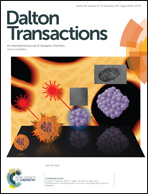Copper(ii) complexes of terminally free alloferon mutants containing two histidyl binding sites inside peptide chain structure and stability†
Abstract
Mononuclear and polynuclear copper(II) complexes of alloferon 1 with point mutations, H1A/H12A H2N-A1GVSGH6GQH9GVA12G-COOH, H1A/H9A H2N-A1GVSGH6GQA9GVH12G-COOH, and H1A/H6A H2N-A1GVSGA6GQH9GVH12G-COOH, have been studied by potentiometric, UV-visible, CD, and EPR spectroscopy, and mass spectrometry (MS) methods. Complete complex speciation at different metal-to-ligand molar ratios ranging from 1 : 1 to 3 : 1 was obtained. Over a wide 6–8 pH range, including physiological pH 7.4, and a 1 : 1 metal-to-ligand molar ratio, the peptides studied formed a CuH−1L complex with the 4N{NH2,N−,2NIm} coordination mode. The presence of the 4N binding site for the CuH−1L complexes prevented the deprotonation and coordination of the second amide nitrogen atom to copper(II) ions (pK−1/−2 7.83–8.07) compared to that of pentaGly (6.81). The amine nitrogen donor and two imidazole nitrogen atoms (H6H9, H6H12 and H9H12) can be considered to be independent metal-binding sites in the species formed. As a consequence, di- and trinuclear complexes for the metal-to-ligand 2 : 1 and 3 : 1 molar ratios dominate in the solution, respectively. For the Cu(II)-H1A/H9A and Cu(II)-H1A/H12A systems, the Cu3H−9L complexes are likely formed by the coordination of amide nitrogen atoms towards C-termini with ring sizes (7,5,5).


 Please wait while we load your content...
Please wait while we load your content...